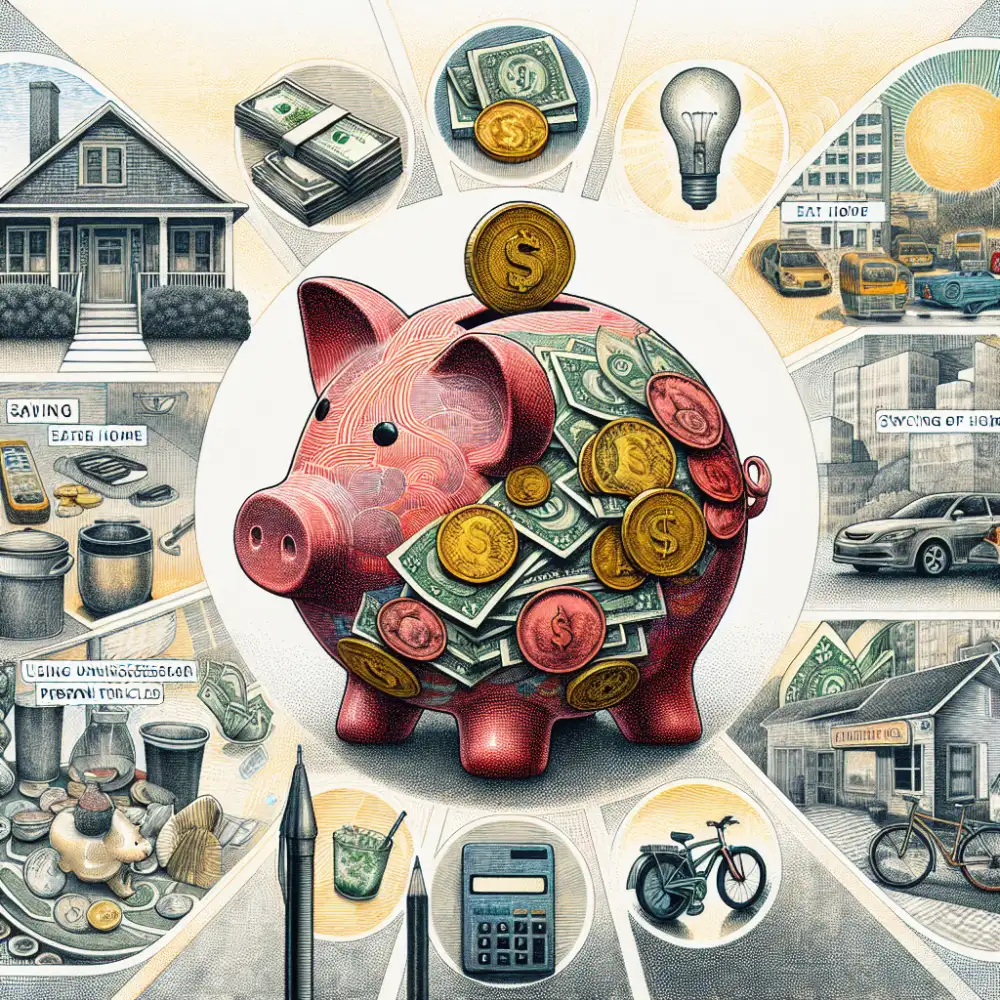Master the Art of Saving Money: Expert Tips and Tricks

- Track Spending
- Create a Budget
- Automate Savings
- Cut Unnecessary Expenses
- Negotiate Bills
- Shop Around for Better Deals
- Use Cash Instead of Credit
- Meal Prep to Save on Food
- Find Free or Low-Cost Entertainment
- Sell Unwanted Items
- Set Financial Goals
- Explore Side Hustles
- Invest Wisely
- Review and Adjust Regularly
Track Spending
One of the most crucial steps to saving money is understanding where it's going. It's easy to overspend when you're not paying attention, but tracking your spending gives you a clear picture of your financial habits. You can do this the old-fashioned way with a pen and notebook, or use budgeting apps available on your smartphone or computer. These apps can often link directly to your bank accounts and credit cards for automatic tracking, making the process even easier.
When tracking your spending, categorize your expenses. Common categories include housing, transportation, food, utilities, entertainment, and debt payments. This allows you to see which areas are consuming the largest chunks of your income. Once you have a month or two of data, analyze your spending habits. Are there any areas where you're consistently overspending? Can you identify any unnecessary expenses? This information is key to creating a realistic budget and identifying areas where you can cut back and save.
Create a Budget
Creating a budget is the cornerstone of saving money. It's your financial roadmap, guiding your spending and ensuring your money is used wisely. Start by tracking your income and expenses. Note down all sources of income and meticulously list every expense, no matter how small. Once you have a clear picture of your cash flow, you can begin to allocate your funds effectively.
Identify your needs versus your wants. Needs are essentials like housing, food, and utilities, while wants are things that enhance your life but aren't crucial for survival. Prioritize your needs and allocate funds for them first. Then, if your budget allows, you can allocate a portion for your wants.
Look for areas where you can cut back. This might involve eating out less, finding more affordable entertainment options, or negotiating better rates for services. Small changes can make a big difference over time. Set realistic savings goals. Whether it's a down payment on a house, a dream vacation, or building an emergency fund, having a specific goal in mind can keep you motivated and on track.
Consider using budgeting apps or spreadsheets to simplify the process. Many free and paid tools can help you track your spending, set financial goals, and visualize your progress. Remember, creating a budget isn't about restricting your life. It's about gaining control of your finances and making your money work for you, allowing you to achieve your financial goals and secure your future.
Automate Savings
Saving money doesn't have to feel like a constant uphill battle. In fact, you can put your savings goals on autopilot with a little planning and the right tools. This is where automating your savings comes in. Start by setting up automatic transfers from your checking account to your savings account each month. Treat this transfer like a non-negotiable bill. Explore the world of micro-saving apps. These clever tools round up your purchases to the nearest dollar and tuck away the spare change into a savings account. You'll be amazed at how quickly these small amounts add up. Make saving effortless by using the power of technology.

Cut Unnecessary Expenses
One of the best ways to save money is to cut unnecessary expenses. These are things you want, not things you need. Identifying wants versus needs can be difficult. Start by tracking your spending for a month. You can use a budgeting app, a spreadsheet, or a notebook. Once you have a good understanding of where your money is going, you can start looking for areas to cut back.
| Feature | Traditional Savings Account | High-Yield Savings Account | Investing in S&P 500 Index Fund |
|---|---|---|---|
| Liquidity | High - Access funds anytime | High - Access funds anytime | Low - Selling assets takes time |
| Risk | Very Low (FDIC insured) | Very Low (FDIC insured) | Medium (Market fluctuations) |
| Potential Return (Annual Average) | Currently ~0.5% | Currently ~2-4% | Historically ~10% (long-term) |
Look for subscriptions you can cancel. This includes streaming services, gym memberships, and magazine subscriptions. Consider whether you are using the subscription enough to justify the cost. If not, cancel it.
Eating out less is a great way to save money. Try to pack your lunch a few times a week instead of buying it. When you do eat out, choose less expensive restaurants or take advantage of discounts and coupons.
Save money on groceries by planning your meals in advance and making a grocery list. Stick to your list and avoid impulse purchases. Look for sales and coupons, and consider buying generic brands.
Save money on entertainment by looking for free or low-cost options. Visit your local library, go for a hike, or have a picnic in the park. Many communities offer free concerts, movies, and other events.
You can save money on transportation by driving less. Walk, bike, or take public transportation whenever possible. If you must drive, try carpooling or combining errands to save on gas.
Lower your utility bills by making small changes at home. Turn off lights when you leave a room, unplug electronics when not in use, and wash your clothes in cold water.
When you are trying to save money, it is important to be mindful of your spending habits. By making small changes to your lifestyle, you can keep more money in your pocket.

Negotiate Bills
Many bills are negotiable, but people don't realize it or don't try. Call your providers and ask for a lower rate or discounts. You might be surprised at how much you can save. Be polite but firm in your negotiations. If you're unhappy with the offer, be prepared to switch providers.
Negotiating medical bills can feel daunting, but it's often possible to reduce what you owe. Contact the billing department and inquire about a payment plan or a discount for paying in full. If you're facing a large bill, don't hesitate to negotiate. Explain your financial situation and see if they can work with you.
Consider bundling services like internet, cable, and phone to save money. Many companies offer discounts for bundling. Explore different providers and compare their bundle offers to find the best deal.
Remember that loyalty doesn't always pay. Sometimes, switching providers is the best way to save money. Don't be afraid to shop around and compare prices from different companies. You might be surprised at the savings you can find by switching.
Shop Around for Better Deals
Don't limit yourself to just one store or brand. Compare prices from different retailers to find the best deals. Use price comparison websites and apps to quickly compare prices from multiple sources. Don't be afraid to negotiate with sellers, especially for big-ticket items. Ask for a lower price, free shipping, or other perks. You might be surprised at how often they're willing to make a deal. Pay attention to sales cycles and seasonal trends. Many products go on sale at predictable times of the year. Plan your purchases accordingly to snag the best discounts. Consider buying used or refurbished items. You can often find gently used electronics, furniture, and other items at a fraction of the cost of new ones. Check online marketplaces, consignment stores, and thrift shops. Be wary of impulse purchases. Before you buy something, ask yourself if you really need it and if it fits into your budget. Take some time to think it over before making a decision.
Use Cash Instead of Credit
One of the simplest yet most effective ways to save money is to start using cash instead of credit cards. Think about it: when you swipe your card, it's easy to overspend without realizing it. The money doesn't feel "real" in the same way that physical cash does. When you pay with cash, you're forced to be more mindful of your spending. You can literally see the money leaving your wallet, which can be a powerful motivator to make smarter purchasing decisions.
Try the "envelope system" for budgeting. Decide how much you can spend in different categories like groceries, entertainment, and clothing. Put that cash in separate envelopes. Once an envelope is empty, you're done spending in that category for the month. This method helps you stick to your budget and avoid overspending in specific areas.


Using cash can also help you negotiate better prices. Many vendors, especially smaller businesses or market vendors, are open to offering discounts for cash payments. This is because they avoid processing fees associated with credit card transactions. Don't hesitate to politely ask if a cash discount is available. You might be surprised at how often this simple question can save you money.
Meal Prep to Save on Food
Meal prepping is your secret weapon for keeping your food budget in check and reducing those tempting takeout orders. Start by planning your meals for the week ahead. This prevents impulse grocery buys and ensures you use what you already have. Look for grocery store sales and discounts, and plan your meals around them. Buying in bulk for staples like rice, pasta, and beans can save money in the long run. Once you've got your ingredients, dedicate a few hours one day a week to prepping your meals. This might involve washing, chopping veggies, cooking grains, or portioning out snacks. Having prepped meals ready to go makes healthy choices more convenient, even on your busiest days. Freezing meals is a game-changer for busy weeks or unexpected late nights at work. Double your recipes and freeze half for future use. Soups, stews, and casseroles freeze particularly well. Don't forget about packing your lunch! Bringing your lunch, even a few times a week, can lead to significant savings compared to buying lunch every day.
Find Free or Low-Cost Entertainment
Entertainment doesn't have to break the bank. There are plenty of ways to have fun without spending a fortune. Check out local community calendars for free events like concerts in the park, outdoor movie nights, or festivals. Many museums offer free admission days or discounted rates during off-peak hours. Explore your city's parks and take advantage of free hiking trails, bike paths, or picnic areas. Libraries often host free events, workshops, and book clubs. Look for free or low-cost entertainment options in your community. You might be surprised at the hidden gems you discover. Volunteering is a rewarding way to give back to your community and meet new people, often with opportunities for free or discounted events.
Consider having friends over for potluck dinners or game nights instead of going out to restaurants or bars. Embrace the art of the staycation and explore your own city or town as a tourist. Visit local attractions, try new restaurants, or simply enjoy the slower pace of life. Look for discounts and deals on entertainment, such as coupons, promo codes, and early bird specials. Many websites and apps offer discounted tickets to movies, concerts, and other events.

Sell Unwanted Items
One effective way to boost your savings is by selling unwanted items. Over time, we accumulate possessions that no longer serve us or hold value. Instead of letting them gather dust, turn them into cash. Declutter your home and list items online through platforms like eBay, Craigslist, or Facebook Marketplace. Consider selling clothes on consignment apps or through online vintage retailers. Hosting a garage sale is another excellent option for offloading larger items. Not only will you earn extra money, but you'll also free up space in your home. Remember to price your items competitively and present them well to attract potential buyers. Selling unwanted items is a win-win situation: you declutter your living space while adding to your savings.
Set Financial Goals
Saving money can feel overwhelming, but it doesn't have to be. It all starts with setting clear financial goals. What do you want to achieve by saving? Is it a down payment for a house, a dream vacation, early retirement, or simply a financial safety net? Write down your goals, both short-term (within a year) and long-term (several years out). Having specific goals in mind will keep you motivated and give your savings a purpose.
Once you have your goals, determine how much you need to save. Break down larger goals into smaller, manageable monthly or weekly targets. This makes saving less daunting and helps you track your progress. Remember to be realistic about what you can afford to save each month. Creating a budget is crucial for understanding your income and expenses. Track your spending for a month or two to identify areas where you can cut back. Look for small, everyday expenses that add up over time, like subscription services you don't use or daily coffees.
Consider setting up automatic transfers from your checking account to your savings account each month. This "pay yourself first" approach ensures that saving becomes a non-negotiable part of your budget. Explore different savings options to find the best fit for your goals. High-yield savings accounts and money market accounts typically offer higher interest rates than traditional savings accounts. Remember, setting financial goals is an ongoing process. Regularly review and adjust your goals and savings plan as your life circumstances change.
The art of saving money is not about deprivation; it's about prioritizing your future self. It's about making conscious choices today that empower you to live the life you desire tomorrow.
Eleanor Caldwell
Explore Side Hustles
Saving money is awesome, but sometimes you need to make more money to reach your goals faster. That's where side hustles come in! They're a fantastic way to boost your income and achieve your financial dreams quicker. The beauty of a side hustle is that it allows you to explore your passions, learn new skills, and diversify your income streams, all while padding your savings account.
The first step is identifying your skills and interests. Are you a whiz at graphic design? Do you have a knack for writing? Or maybe you're a social media guru. Once you've pinpointed your strengths, you can start exploring side hustles that align with them.
There are tons of options out there! If you enjoy working with people, consider becoming a virtual assistant, freelance writer, or social media manager. If you prefer working independently, explore options like online tutoring, web development, or graphic design. Platforms like Upwork, Fiverr, and Etsy can connect you with potential clients and help you get started.
Remember, consistency is key when it comes to side hustles. Set realistic goals, manage your time effectively, and stay motivated. With dedication and effort, your side hustle can become a significant source of income, allowing you to save more, pay off debt, or even invest in your future. So, start exploring your options today and unlock your earning potential!
Invest Wisely
Saving money is not just about stashing away a few dollars here and there. It's about making conscious decisions and adopting habits that pave the way for a secure financial future. Start by setting clear financial goals. Whether it's a down payment on a house, a dream vacation, or a comfortable retirement, having specific objectives gives your saving purpose and motivation. Once you know what you're saving for, create a realistic budget to track your income and expenses. Identify areas where you can cut back on unnecessary spending and allocate more funds towards your savings goals.
Explore different savings options to find the best fit for your needs. Consider high-yield savings accounts that offer better interest rates than traditional accounts. Look into certificates of deposit (CDs) for fixed interest rates over a set period. For long-term goals like retirement, explore tax-advantaged accounts such as 401(k)s or Individual Retirement Accounts (IRAs). Automate your savings by setting up regular transfers from your checking account to your savings account. This "pay yourself first" approach ensures that saving becomes a non-negotiable part of your financial routine.

Small changes in spending habits can make a significant difference over time. Consider brewing your own coffee instead of buying it daily, packing your lunch instead of eating out, and exploring affordable entertainment options like free concerts or community events. Review your subscriptions and memberships regularly and cancel those you don't use frequently. Negotiate better rates for services like cable, internet, and insurance. Remember, every dollar saved is a dollar earned towards your financial goals.
Review and Adjust Regularly
Life is constantly changing, and so are your financial circumstances. What worked for you a few months ago might not be the most effective strategy today. That's why it's crucial to review and adjust your savings plan regularly. Start by scheduling a "financial check-up" with yourself every three to six months. During this time, look at your income, expenses, and savings goals. Have you received a raise or started a side hustle? Adjust your savings rate accordingly. Did your rent increase or grocery bills skyrocket? Identify areas where you can cut back and redirect funds to your savings.
Don't be afraid to tweak your savings goals as life unfolds. If you're saving for a down payment on a house, but unexpectedly need to prioritize car repairs, it's okay to adjust your timeline or monthly savings target. Flexibility is key to staying motivated and on track. Remember, saving money is a marathon, not a sprint. By reviewing and adjusting your plan regularly, you can navigate life's financial twists and turns while still reaching your goals.
Published: 12. 07. 2024
Category: Food



